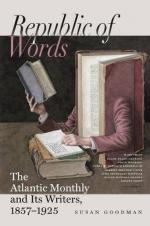Before leaving these English churches and monuments, let us enter, if but for a moment, the famous Beauchamp Chapel at Warwick. The finest of the views (323, 324) recalls that of the Black Prince’s tomb, as a triumph of photography. Thus, while the whole effect of the picture is brilliant and harmonious, we shall find, on taking a lens, that we can count every individual bead in the chaplet of the monk who is one of the more conspicuous reliefs on the sarcophagus. The figure of this monk itself is about half an inch in height, and its face may be completely hidden by the head of a pin. The whole chapel is a marvel of workmanship and beauty. The monument of Richard Beauchamp in the centre, with the frame of brass over the recumbent figure, intended to support the drapery thrown upon it to protect the statue,—with the mailed shape of the warrior, his feet in long-pointed shoes resting against the muzzled bear and the griffin, his hands raised, but not joined,—this monument, with the tomb of Dudley, Earl of Leicester,—Elizabeth’s Leicester, —and that of the other Dudley, Earl of Warwick,—all enchased in these sculptured walls and illuminated through that pictured window, where we can dimly see the outlines of saints and holy maidens,—form a group of monumental jewels such as only Henry VII.’s Chapel can equal. For these two pictures (323 and 324) let the poor student pawn his outside-coat, if he cannot have them otherwise.
Of abbeys and castles there is no end, ago No. 4, Tintern Abbey, is the finest, on the whole, we have ever seen. No. 2 is also very perfect and interesting. In both, the masses of ivy that clothe the ruins are given with wonderful truth and effect. Some of these views have the advantage of being very well colored. Warwick Castle (81) is one of the best and most the interesting of the series of castles; Caernarvon is another still more striking.
We may as well break off here as anywhere, so far as England is concerned. England is one great burial-ground to an American. As islands are built up out of the shields of insects, so her soil is made the land of Burns, and see what one man can do to idealize and glorify the common life about him! Here is a poor “ten-footer”, as we should call it, the cottage William “Burness” built with his own hands, where he carried his young bride Agnes, and where the boy Robert, his first-born, was given to the light and air which he made brighter and freer for mankind. Sit still and do not speak,—but see that your eyes do not grow dim as these pictures pass before them: The old hawthorn under which Burns sat with Highland Mary,—a venerable duenna-like tree, with thin arms and sharp elbows, and scanty chevelure of leaves; the Auld Brig o’ Doon (No. 4),—a daring arch that leaps the sweet stream at a bound, more than half clad in a mantle of ivy, which has crept with its larva-like feet beyond the key-stone; the Twa Brigs of Ayr, with the beautiful reflections in the stream that shines under their eyebrow-arches; and poor little Alloway Kirk, with its fallen roof and high gables. Lift your hand to your eyes and draw a long breath,—for what words would come so near to us as these pictured, nay, real, memories of the dead poet who made a nation of a province, and the hearts of mankind its tributaries?




